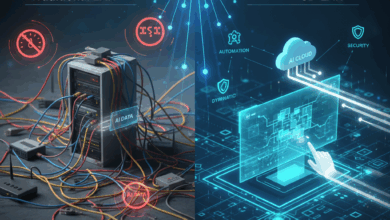In the dynamic world of cybersecurity, protecting who gets access to what has always been the fundamental mission of Identity and Access Management (IAM).
Yet, as we stand in mid-2025, the sheer volume of identities – human, machine, and even ephemeral – means traditional IAM struggles to keep pace.
This is precisely where AI and Machine Learning in IAM are not just changing the game; they’re becoming the very brain of modern identity security. This is especially true within a robust Zero Trust framework.
The integration of artificial intelligence and machine learning transforms IAM from a largely static, rule-based system. It becomes a dynamic, adaptive, and predictive powerhouse. It’s about more than just granting access; it’s about continuously verifying, assessing risk in real-time, and automating responses faster than any human team ever could.
The Revolution of AI and Machine Learning in IAM
Traditional IAM systems often rely on static policies and predefined roles. While effective for basic control, they struggle with the dynamic nature of today’s digital landscape. They are particularly vulnerable to sophisticated cyber threats that exploit subtle behavioural anomalies.
AI and ML, however, bring unprecedented capabilities to the table. They enable IAM systems to analyse vast quantities of data. This allows them to recognise patterns in user behaviour and access history.
This capability helps them quickly detect deviations that may signal unauthorised access or internal threats. It significantly bolsters the overall security framework.
One of the most significant contributions of AI and Machine Learning in IAM is the automation of decision-making. AI algorithms can automatically approve or deny access requests. They do this based on real-time context and a user’s behaviour.
This level of automation not only speeds up processes but also drastically reduces the likelihood of human error. It makes the IAM system more reliable and efficient.
Machine Learning, a subset of AI, is particularly adept at learning and adapting to new information. In IAM, ML algorithms learn typical user behaviour patterns. This enables them to swiftly detect anomalies.
If a user’s behaviour significantly deviates from their usual pattern – perhaps accessing sensitive data they normally don’t – the system can flag this. This acts as a potential security risk, aiding in the early detection of insider threats and potential data breaches.
This also translates to advanced risk-based authentication. The system assesses the risk level of a login attempt using various factors. These include user location, device used, time of access, and behavioural patterns.
If an attempt seems risky, the system can automatically prompt additional authentication steps. This might be a biometric scan or a different MFA method, adding an extra layer of security.
AI and Machine Learning in IAM Power Zero Trust
The cornerstone of modern cybersecurity, Zero Trust Architecture, becomes truly intelligent with AI. Zero Trust demands “never trust, always verify” and continuous validation of every access request.
AI provides the real-time insights and adaptive capabilities needed to enforce this principle across every single interaction. AI-powered IAM solutions analyse user behaviour, location, device information, and historical data. They then dynamically determine access permissions.
For example, if an employee typically logs in from London but suddenly attempts to access a critical system from an unknown IP address in a different country, AI can immediately flag or even block the request. This intelligent access control is crucial.
Beyond a one-time login, AI enables continuous user verification. It does this by constantly monitoring behaviour patterns. Any deviation from a user’s normal routine, such as unusual keystroke dynamics or atypical application usage, can trigger immediate security measures.
This might include prompting for multi-factor authentication (MFA) again, or even revoking access mid-session. This dynamic verification is central to Zero Trust.
AI also fuels automated threat detection and response within IAM. AI-driven Security Information and Event Management (SIEM) tools, like IBM Security QRadar leveraging AI, can process vast amounts of identity-related data in real time.
They detect anomalies, identify phishing attempts, and spot lateral movement within networks that would be invisible to human analysts. For instance, AI could identify an employee accessing sensitive data outside of business hours and automatically restrict their access or alert the security team.
Furthermore, AI contributes to least privilege access. It does this by intelligently suggesting and enforcing the precise permissions required for each user and machine identity. It helps in the automation of Just-in-Time (JIT) and Just-Enough-Access (JEA) models.
These models grant temporary, highly specific permissions only when and where they are needed. This is a core tenet of Zero Trust, greatly reducing the attack surface.
IAM Vendors
Major IAM vendors are rapidly integrating AI and Machine Learning in IAM platforms. They are bringing these advanced capabilities to life for enterprises worldwide.
Okta, a leader in identity, leverages AI in its Adaptive MFA and Identity Governance solutions. Their AI analyses contextual factors like location, device, and network to dynamically adjust authentication requirements. This offers a seamless yet secure user experience.
It can detect credential stuffing attacks by analysing login patterns and bot behaviour. Their access governance tools also utilize ML to automate access reviews and detect privilege creep.
Microsoft Entra ID (formerly Azure Active Directory) employs machine learning extensively within its Conditional Access policies. It continuously analyses sign-in attempts for real-time risk. This is based on factors like IP location, device state, and user behaviour.
If a sign-in is deemed risky, it can enforce MFA, block access, or require a password change. Entra ID also uses AI for identity protection, detecting compromised credentials and unusual sign-in behaviours.
IBM Security Verify utilizes AI to establish baseline user behaviour and detect suspicious activities in real-time. Their identity analytics feature simplifies access governance and improves compliance. It does this by identifying outliers in access patterns.
It’s particularly strong in monitoring privileged accounts for anomalous behaviour that might indicate an insider threat.
Ping Identity’s solutions apply AI algorithms to evaluate login attempts and detect suspicious activities. This contributes to their adaptive authentication capabilities. Their platform integrates behavioural analytics to assess risk during authentication and throughout a session. This ensures continuous verification for a true Zero Trust posture.
These examples illustrate that AI isn’t just an add-on. It’s becoming an intrinsic part of how these leading platforms deliver intelligent identity security. This enables enterprises to manage the complexities of Zero Trust.
Challenges and Future Directions
Despite the immense benefits, integrating AI and Machine Learning in IAM is not without its challenges. Data privacy is a significant concern, as AI models rely on vast amounts of user activity data. Organizations must ensure compliance with regulations like GDPR and CCPA.
Another challenge is potential AI bias. If training data is skewed or incomplete, AI models can inadvertently introduce biases. This could lead to incorrect threat assessments or unfair access restrictions. Careful model training and continuous monitoring are essential.
Integration with legacy IAM systems and existing IT infrastructure can also be complex. Many enterprises operate with a mix of old and new technologies. This requires thoughtful planning and investment for seamless integration of AI-driven solutions.
Looking Ahead
Looking ahead, the future of AI and Machine Learning in IAM is exciting. We’ll see even more sophisticated behavioural biometrics. This moves beyond simple fingerprint or facial recognition. It will involve analysing how a user types, holds their device, or navigates applications.
Predictive AI will become even more common. It will anticipate threats before they materialize. It does this by analysing global attack patterns and enterprise-specific vulnerabilities.
The rise of AI-powered “copilots” for IAM administrators is also on the horizon. These intelligent assistants will help automate complex tasks. They will provide real-time contextual guidance and streamline approvals through natural language interactions. This will further enhance operational efficiency.
The convergence of AI and Machine Learning in IAM is fundamentally transforming cybersecurity. It’s empowering organisations to move beyond static, reactive defences. It drives them towards dynamic, proactive, and continuously verified access control.
For enterprises committed to building a robust Zero Trust framework, AI-driven IAM is not just a technological advancement. It’s an indispensable strategy for safeguarding digital identities and protecting critical assets in an increasingly intelligent and interconnected world.



